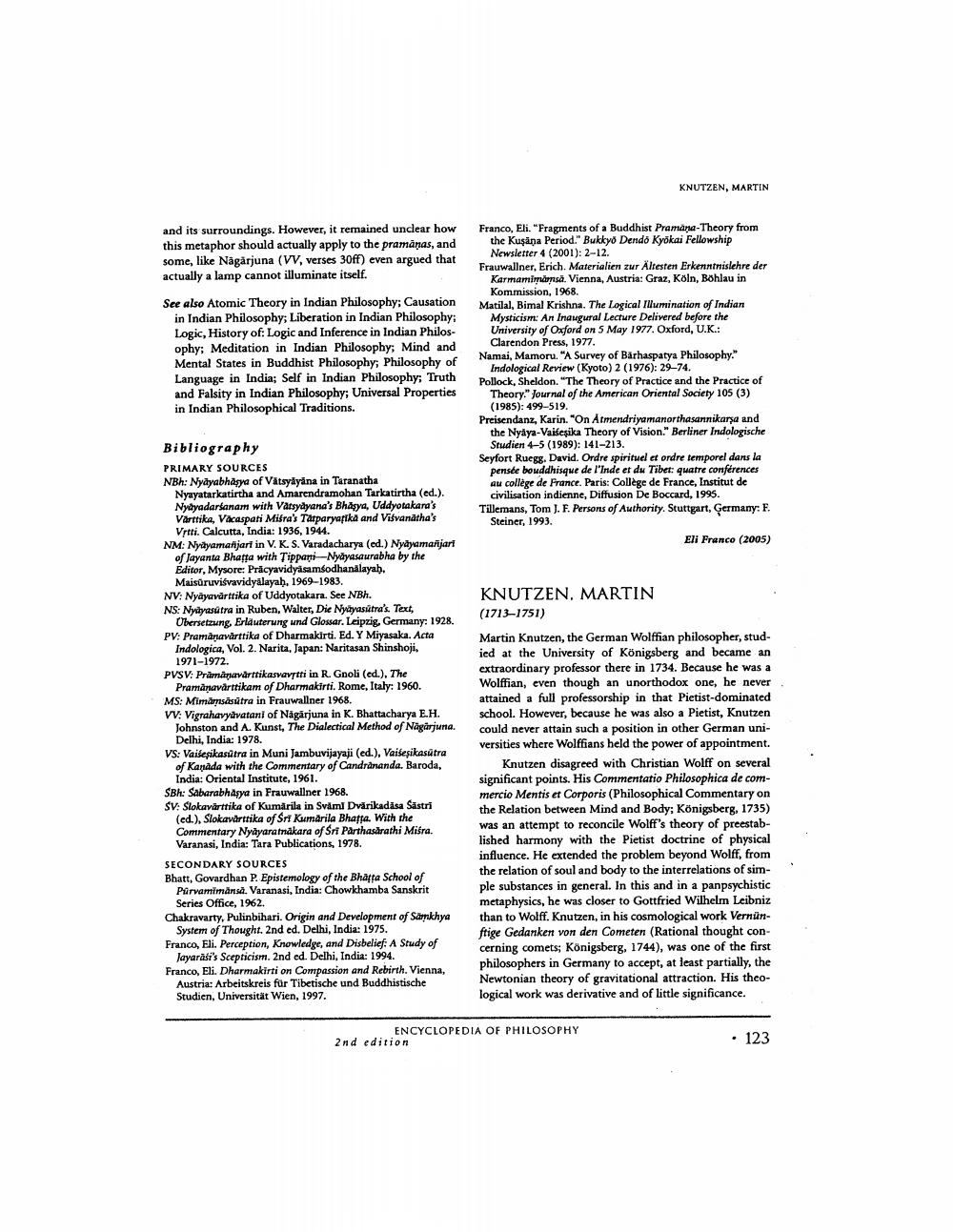________________ KNUTZEN, MARTIN and its surroundings. However, it remained unclear how this metaphor should actually apply to the pramanas, and some, like Nagarjuna (VV, verses 30ff) even argued that actually a lamp cannot illuminate itself. See also Atomic Theory in Indian Philosophy; Causation in Indian Philosophy; Liberation in Indian Philosophy; Logic, History of: Logic and Inference in Indian Philosophy; Meditation in Indian Philosophy; Mind and Mental States in Buddhist Philosophy; Philosophy of Language in India; Self in Indian Philosophy; Truth and Falsity in Indian Philosophy; Universal Properties in Indian Philosophical Traditions. Franco, Eli. "Fragments of a Buddhist Pramana-Theory from the Kusana Period." Bukkyo Dendo Kyokai Fellowship Newsletter 4 (2001): 2-12. Frauwallner, Erich. Materialien zur Altesten Erkenntnislehre der Karmamimamsa. Vienna, Austria: Graz, Koln, Bohlau in Kommission, 1968. Matilal, Bimal Krishna. The Logical Illumination of Indian Mysticism: An Inaugural Lecture Delivered before the University of Oxford on 5 May 1977. Oxford, U.K.: Clarendon Press, 1977. Namai, Mamoru. "A Survey of Barhaspatya Philosophy." Indological Review (Kyoto) 2 (1976): 29-74. Pollock, Sheldon. "The Theory of Practice and the Practice of Theory." Journal of the American Oriental Society 105 (3) (1985): 499-519. Preisendanz, Karin. "On Atmendriyamanorthasannikarsa and the Nyaya-Vaisesika Theory of Vision." Berliner Indologische Studien 4-5 (1989): 141-213. Seyfort Ruegg, David. Ordre spirituel et ordre temporel dans la pensee bouddhisque de l'Inde et du Tibet: quatre conferences au college de France. Paris: College de France, Institut de civilisation indienne, Diffusion De Boccard, 1995. Tillemans, Tom J. F. Persons of Authority. Stuttgart, Germany: F. Steiner, 1993. Eli Franco (2005) Bibliography PRIMARY SOURCES NBh: Nyayabhasya of Vatsyayana in Taranatha Nyayatarkatirtha and Amarendramohan Tarkatirtha (ed.). Nyayadarsanam with Vatsyayana's Bhasya, Uddyotakara's Varttika, Vacaspati Misra's Tatparyatika and Visvanatha's Vrtti. Calcutta, India: 1936, 1944. NM: Nyayamanjari in V. K. S. Varadacharya (ed.) Nyayamanjari of Jayanta Bhatta with Tippani-Nyayasaurabha by the Editor, Mysore: Pracyavidyasamsodhanalayah, Maisuruvisvavidyalayah, 1969-1983. NV: Nyayavarttika of Uddyotakara. See NBh. NS: Nyayasutra in Ruben, Walter, Die Nyayasutra's. Text, Obersetzung, Erlauterung und Glossar. Leipzig, Germany: 1928. PV: Pramanavarttika of Dharmakirti. Ed. Y Miyasaka. Acta Indologica, Vol. 2. Narita, Japan: Naritasan Shinshoji, 1971-1972 PVSV: Pramanavarttikasvavrtti in R. Gnoli (ed.), The Pramanavarttikam of Dharmakirti. Rome, Italy: 1960. MS: Mimamsasutra in Frauwallner 1968. VV: Vigrahavyavatani of Nagarjuna in K. Bhattacharya E.H. Johnston and A. Kunst, The Dialectical Method of Nagarjuna. Delhi, India: 1978. VS: Vaisesikasutra in Muni Jambuvijayaji (ed.), Vaisesikasutra of Kanada with the Commentary of Candrananda. Baroda, India: Oriental Institute, 1961. SBh: Sabarabhasya in Frauwallner 1968. SV: Slokavarttika of Kumarila in Svami Dvarikadasa Sastri (ed.), Slokavarttika of Sri Kumarila Bhatta. With the Commentary Nyayaratnakara of Sri Parthasarathi Misra. Varanasi, India: Tara Publications, 1978. SECONDARY SOURCES Bhatt, Govardhan P. Epistemology of the Bhatta School of Purvamimansa. Varanasi, India: Chowkhamba Sanskrit Series Office, 1962. Chakravarty, Pulinbihari. Origin and Development of Samkhya System of Thought. 2nd ed. Delhi, India: 1975. Franco, Eli. Perception, Knowledge, and Disbelief: A Study of Jayarasi's Scepticism. 2nd ed. Delhi, India: 1994. Franco, Eli. Dharmakirti on Compassion and Rebirth. Vienna, Austria: Arbeitskreis fur Tibetische und Buddhistische Studien, Universitat Wien, 1997. KNUTZEN, MARTIN (1713-1751) Martin Knutzen, the German Wolffian philosopher, studied at the University of Konigsberg and became an extraordinary professor there in 1734. Because he was a Wolffian, even though an unorthodox one, he never attained a full professorship in that Pietist-dominated school. However, because he was also a Pietist, Knutzen could never attain such a position in other German universities where Wolffians held the power of appointment. Knutzen disagreed with Christian Wolff on several significant points. His Commentatio Philosophica de commercio Mentis et Corporis (Philosophical Commentary on the Relation between Mind and Body; Konigsberg, 1735) was an attempt to reconcile Wolff's theory of preestablished harmony with the Pietist doctrine of physical influence. He extended the problem beyond Wolff, from the relation of soul and body to the interrelations of simple substances in general. In this and in a panpsychistic metaphysics, he was closer to Gottfried Wilhelm Leibniz than to Wolff. Knutzen, in his cosmological work Vernunftige Gedanken von den Cometen (Rational thought concerning comets; Konigsberg, 1744), was one of the first philosophers in Germany to accept, at least partially, the Newtonian theory of gravitational attraction. His theological work was derivative and of little significance. ENCYCLOPEDIA OF PHILOSOPHY 2nd edition * 123




